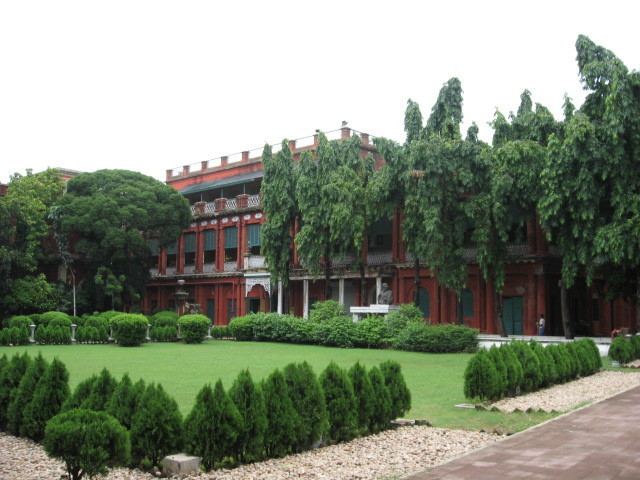Elevation 11 m Population 34,819 (2001) | Ward 22, 23, 41 Parliamentary constituency Kolkata Uttar Local time Tuesday 12:52 AM | |
 | ||
Weather 19°C, Wind SW at 0 km/h, 79% Humidity Points of interest Jorasanko Thakur Bari, Marble Palace, Shani Mandir | ||
Jorasanko thakurbari 8th may 2010 before 150 years birthday celebration of rabindranath tagore
Jorasanko (Bengali: জোড়াসাঁকো Joṛashãko) is a neighbourhood in north Kolkata. It is so called because of the two (jora) wooden or bamboo bridges (sanko) that spanned a small stream at this point.
Contents
- Jorasanko thakurbari 8th may 2010 before 150 years birthday celebration of rabindranath tagore
- Map of Jorasanko Kolkata West Bengal
- Monihar best romantic rabindrasangeet album by rupankar shantiniketan to jorasanko thakurbari
- History
- Rabindra Sarani
- Jorasanko Natyashala
- Recent developments
- References
Map of Jorasanko, Kolkata, West Bengal
Monihar best romantic rabindrasangeet album by rupankar shantiniketan to jorasanko thakurbari
History
Apart from the distinguished seat of the Tagore family, traditionally known as the Jorasanko Thakur Bari, it was also home of the Singhas (including Kaliprasanna Singha), the Pals (including Krishnadas Pal), and the families of Dewan Banarasi Ghosh,Gokul Chandra Daw, Narsingha Chandra Daw, Prafulla Chandra Gain, and Chandramohan Chatterji. “The area thus became the cradle of Bengal Renaissance.” It was earlier known as Mechuabazar.
The earliest list of thanas (police stations) in Kolkata was prepared in 1785 for both police and municipal administration. Jorasanko was one of the 31 thanas then recorded.
Amongst the institutions in Jorasanko are – Adi Brahmo Samaj, the Jorasanko Bharati Natya Samaj, the Kalikata Haribhakti Pradayani Sabha, the Minerva Library and Oriental Seminary. The Oriental Seminary started in 1829 by the educator Gour Mohan Addy, was one of the earliest privately run, first-rate, Hindu supported modern school in Kolkata, open to middle and lower middle-class Hindu boys only.
Rabindra Bharati University, the third university in Kolkata, was set up in 1962 in the Tagore family’s house at Jorasanko, primarily as a centre for music and fine arts, but extended subsequently to arts and humanities.
Rabindra Sarani
Jorasanko is located on Rabindra Sarani (earlier Chitpore Road.) “The great thoroughfare, which commencing in the extreme south, assumes the various names of Russa Road, Chowringhee Road, Bentick Street, Chitpore Road, and Barrackpore Trunk Road, forms a continuation of the Dum Dum Road and was the old line of communication between Morshedabad and Kalighat. It is said to occupy the site of the old road made by the Sabarna Roy Choudhurys, the old zemindars of Calcutta, from Barisha, where the junior branch resided, to Halisahar, beyond Barrackpore, which was the seat of the senior branch.” Some people refer to the entire stretch through which Chitpore Road ran as Chitpore or Chitpur. That includes Jorasanko.
Jorasanko Natyashala
There were two Jorasanko Natyashalas. The earlier one was organised by Peary Mohan Bose at his house on Banarasi Ghose Street, in Jorasanko. The only play staged was Shakespeare’s Julius Caeser on 3 May 1854.
Ganendranath Tagore established the second Jorasanko Natyasala, a home theatre, in 1865 and staged Krishnakumari written by Michael Madhusudan Dutta that year itself. Young Jyotirindranath had the first opportunity to act in it in the role of Ahalyadevi. At first men played women’s roles, but subsequently women of the family also acted before an audience of friends and relatives and even late before the public.
As there were few good plays in Bengali, which could be taken up for staging, Ganendranath announced a prize for writing plays. Nabanatak written by Ramnarayan Tarkaratna won the first prize. He awarded the playwright Rupees two hundred (a large sum in those days) and promised to bear the cost of printing a thousand copies of the play.
Recent developments
Buddhadev Dasgupta won the award for the Best Direction for the Year 2001 for the film Jorasanko Thakurbari for artistically unfolding the history of the house of the Tagores. Joanne Taylor who has written a book on the Forgotten Palaces of Calcutta was spell bound by the Jorasanko Thakur Bari. “These structures form the fabric of Kolkata’s history,” she says.
Jorasanko is an important centre of shell industry in Kolkata. However, the industry has not been in good shape in recent years.
